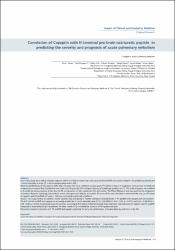Correlation of Copeptin with N-terminal pro-brain natriuretic peptide in predicting the severity and prognosis of acute pulmonary embolism Copeptin in acute pulmonary embolism

View/
Access
info:eu-repo/semantics/openAccessDate
2021Author
Yavaşi, ÖzcanKayayurt, Kamil
Bilir, Özlem
Ersunan, Gökhan
Özyurt, Songül
Kırbaş, Aynur
Uğraş, Erhan
Metadata
Show full item recordCitation
Yavasi, O., Kayayurt, K., Bilir, O., Ersunan, G., Ozyurt, S., Kirbas, A. & Uğras, E. (2021). Correlation of Copeptin with N-terminal pro-brain natriuretic peptide in predicting the severity and prognosis of acute pulmonary embolism Copeptin in acute pulmonary embolism. Annals of Clinical and Analytical Medicine DOI: 10.4328/ACAM.20645Abstract
Aim: In this study, we aimed to compare copeptin with N-terminal pro-brain natriuretic peptide (NT-proBNP) and cardiac troponin I for predicting severity and 3-month mortality in acute PE in the emergency department (ED).
Material and Methods: All ED patients older than 18 years who were confirmed to have acute PE within six hours of diagnostic work-up were enrolled and prospectively screened. Risk stratification was made according to the 2014 European Society of Cardiology guideline on PE. The study endpoints were defined as 3-month mortality, presence of non-low risk PE, and presence of right ventricular (RV) dysfunction. The Mann-Whitney Ll test was used for the comparison of medians. Receiver operating characteristic curves were generated and the area under the curve (AUC) was calculated to determine the best cut-off values of copeptin and NT-proBNP. A P value < 0.05 was considered statistically significant.
Results: The study enrolled 82 patients. Twelve patients who died during 3 months had higher concentrations of NT-proBNP and copeptin, but not troponin I. The AUCs of NT-proBNP and copeptin to accurately predict the 3-month mortality were 0.73 +/- 0.09 (95% CI, 0.62 - 0.82; p = 0.013) and 0.78 +/- 0.09 (95% CI, 0.68 - 0.86; p = 0.003), respectively. Low-risk patients, according to Pulmonary Embolism Severity Index, had lower concentrations of copeptin and NT-proBNP compared to intermediate-high risk patients. All three markers discriminated the presence of RV dysfunction truly.
Discussion: Copeptin correlates with NT-proBNP and appears beneficial for early risk stratification of acute pulmonary embolism in the ED.
Source
Annals of Clinical and Analytical MedicineVolume
12URI
file:///C:/Users/Nagihan%20Kaynak/Downloads/10.4328%E2%96%A102ACAM.20645.pdfhttps://hdl.handle.net/11436/6312

















